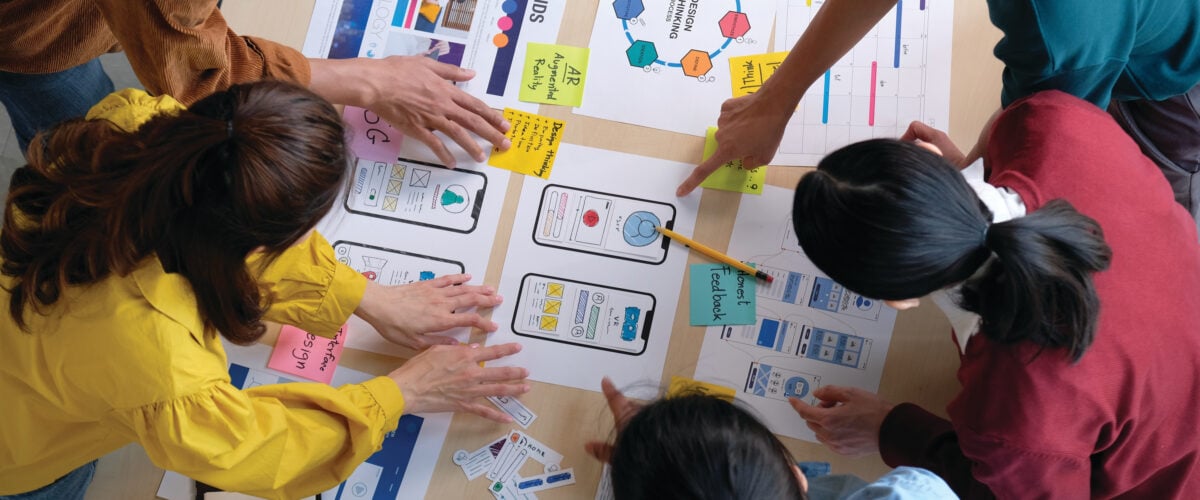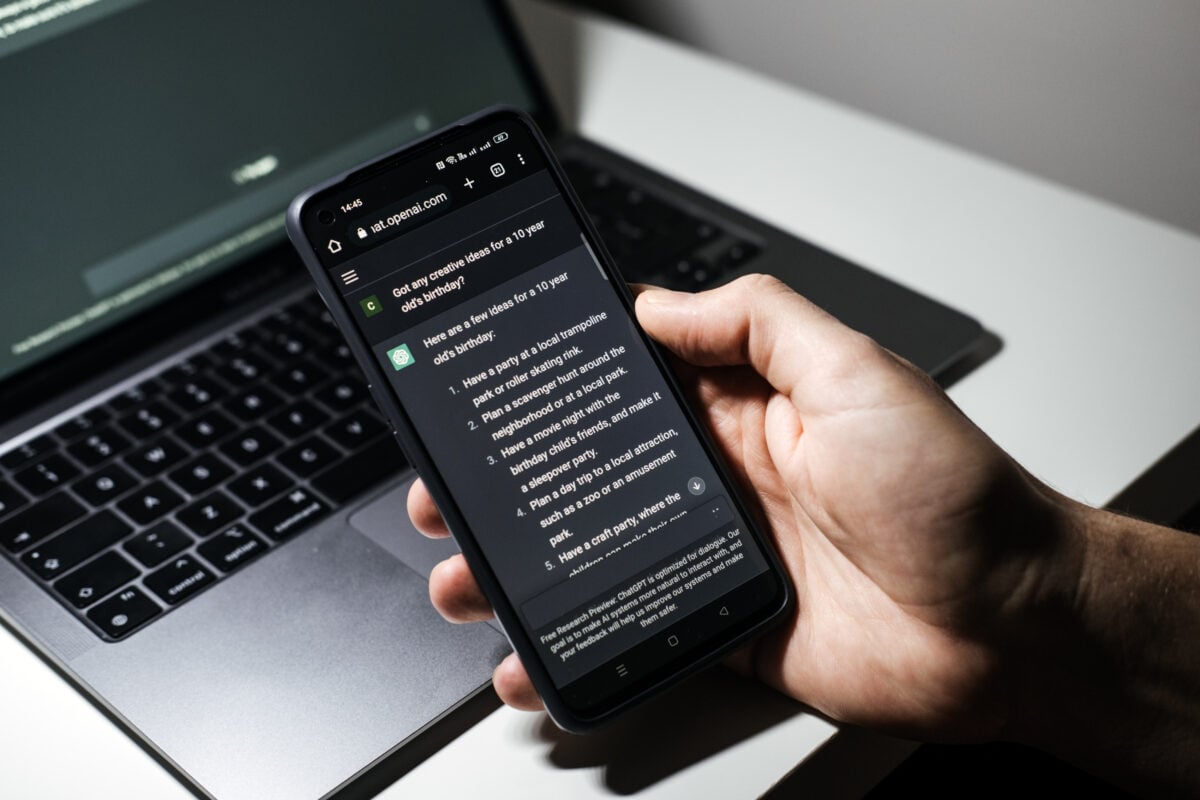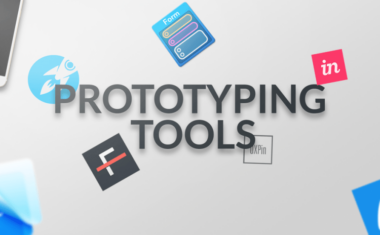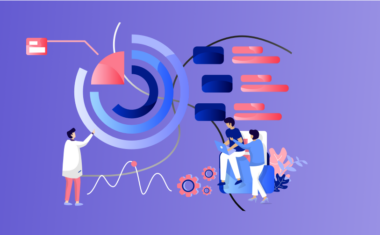Free UX Design Course
Dive into UX design with our free starter course. Transform your creative ideas into user-friendly solutions.
UX design has come a long way since Apple Computer designer Don Norman first coined the term ‘user experience’ in 1993. While the first known UX designers created the touchtone keypad for the telephone, today’s designers build seamless cross-device experiences, hyper-personalization at scale, and program intuitive micro-interactions that guide users through tasks.
Similarly, the number of UX designers in the field has grown steadily since the 1950s. The Nielsen Norman Group predicts that by 2050, there will be over 100 million UX professionals globally (currently around one million). Companies grow their design teams as they increase their level of UX maturity, which requires a strong digital presence. Now, every company is considered a “tech company” in today’s digital-first world, given the necessity of having a digital presence.
UX designers design and build seamless web and mobile experiences that enable users to accomplish their goals. They identify user pain points, conduct user research, and optimize digital interfaces for user-friendliness, retention, and goal completion.
How have the recent layoffs affected the demand for UX designers?
In the aftermath of the mass layoffs affecting Big Tech at the beginning of this year—the tech sector shed nearly 150,000 employees in the last five months alone—would-be UX designers are feeling understandably trepidatious about their odds of breaking into the industry. Data shows the largest job cuts were in HR and talent sourcing (27.8%), followed by engineering (22%), marketing (7.1%), and customer service (4.6%).
Job seekers have speculated that the design industry might be “oversaturated” as competition for UX jobs intensifies. One senior designer wrote in a recent Medium post that he’d reviewed over 300 applications for one UX design role.

“There’s still a lot of demand for UX designers, but it’s harder than it was during or just after the COVID pandemic when companies thought people would permanently change their digital habits after being cooped up for so long,” says Nick Groeneveld, a senior UX consultant at Capgemini who runs his own UX consultancy, The Designer’s Toolbox.
Data shows demand for UX designers is growing. According to the U.S. Bureau of Labor Statistics, the employment rate for web developers and digital designers—which includes UX designers—is expected to grow 23% from 2021-2031, much faster than average. However, junior roles seem to be shrinking.
When the labor market is tight, companies hesitate to hire entry-level designers because of the time and cost needed to upskill a new worker. Junior designers need guidance from senior designers—something a small company may not have. Moreover, most new designers lack experience working on real-world projects, collaborating with other designers, and adhering to time, budget, and engineering constraints—meaning they need a longer ramp-up time and may require on-the-job training.
With bargaining power slowly shifting back to employers following historical wage growth in 2022, job seekers must clear a higher bar.
“I’ve noticed that hiring managers are more critical about who they take on,” says Groeneveld. “We’ve had some hiring pauses—no layoffs, but hiring is slowing down.”
Meanwhile, many veteran graphic designers began shifting to UX design to take advantage of better opportunities and higher salaries, making it harder for new designers to compete.
“Graphic designers began to realize it’s super important to have UX design skills in today’s digital world,” says Aida Nogués, a product designer at Sage and a mentor for Springboard’s UI/UX Design Career Track, who made the transition herself seven years ago.
What does this mean for the future of UX design?
UX design begets a high return on investment—meaning companies are unlikely to stop investing in it. A survey by Nielsen Norman Group found that after redesigning for usability, companies saw an average improvement in KPIs of 75%. This includes conversion rates, traffic, user performance, and target feature usage (the number of users who complete a critical task or click an important button).
While the gains have shrunk over the years—the ROI was 135% when the study was first conducted in 2003—UX design has since become more standardized and entrenched in core business practices.
The field remains promising overall. Glassdoor ranked UX designer as the 24th best job out of 50, based on job satisfaction ratings (4.0/5), median base salary ($97,047), and number of openings. The salary for entry-level UX designers is $77,123.

However, design roles may become more specialized as the trend toward accessibility design and hands-free interfaces necessitates specific skill sets.
“Design is a craft that takes a lot of time, persistence, and hard work to become good at,” says Adam Casiddy, UX designer at WEX and a mentor for Springboard’s UI/UX Design Career Track. “That said, I still think there’s a lot of opportunity for people who want to be in this field, but you will have to go above and beyond your education program or bootcamp to prove your employability.”
AI-Assisted Design: What Can AI Do That a Human Can’t?
San Francisco-based AI research lab OpenAI released its generative AI tool, GPT-3, in November 2022 to much fanfare. Generative AI is a language learning model capable of generating text, images, and other media in response to prompts. Users were astounded at the chatbot’s ability to field questions, create content, and write boilerplate code.
Naturally, this begged the question of whether jobs like digital marketing, copywriting, programming, and data science could be automated. Five months later, OpenAI followed up with GPT-4, its most advanced large language model yet. The bot can pass major tests like the bar exam (90% grade), write coherent books, create video games, perform pharmaceutical drug discovery, and even generate entire lawsuits.
Engineers at Microsoft, Goldman Sachs, and Amazon have reportedly used ChatGPT to help them write code. However, AI’s ability to disrupt the design field remains limited.
AI can automate certain design tasks, such as generating layouts and color schemes or parameterizing designs to fit within business constraints. AI can personalize user experiences by analyzing user data and behavior and analyzing content for readability. Theoretically, you could train a neural network with old design variants and the associated requirements, then let the network generate a design from new requirements.
However, designers bring a human-centered perspective to their work. Conversely, AI struggles to understand nuances and social cues. It cannot create truly original content or filter its own biases.
The rise of AI tech makes UX designers more crucial than ever before. While AI tools can design aesthetically pleasing interfaces, they don’t have the faculties to understand usability, friction, and user-friendliness. Human-centered design is at the core of UX. Designers understand user needs and behavior and create interfaces to meet those needs. People must also understand the emotional and psychological needs of design, which are essential in creating a positive user experience.
AI development itself may increase the need for skilled UX designers who understand what effective human-AI collaboration looks like. IBM recently coined human-centered AI (HCAI), “an emerging discipline intent on creating AI systems that amplify and augment rather than displace human abilities.”
HCAI seeks to “preserve human control in a way that ensures AI meets our needs while operating transparently, delivering equitable outcomes, and respecting privacy.”
“I think there will be more demand for designers who know how to leverage AI as part of their job,” says Cassidy. “We’ll probably also start seeing UX design jobs involving the design of parts of the AI itself or the interface humans use to interact with it.”
Developing human-centered AI systems requires, well, human knowledge. AI applications must reflect realistic conceptions of user needs and human psychology. According to user-centered design pioneer Don Norman, effective design is to “accept human behavior the way it is, not the way we wish it to be.”

When designing digital interfaces, humans are needed for their tacit knowledge—the intuitive know-how and common sense gained by experience. For example, understanding the logic of a user flow requires the designer to put themselves in the user’s shoes, which calls for empathy and life experience. AI, on the other hand, is proficient at tasks requiring explicit or crystallized knowledge—facts, numbers, and words that can be used in logical deductions.
However, AI is slowly improving at automation tasks associated with human tacit knowledge. Examples include facial recognition (whose uses are often controversial), driving cars, sensing emotions (or at least classifying them according to predetermined labels), and interpreting spoken words using natural language processing.
Still, most of a designer’s time is not spent using design tools, which limits the extent to which the design process can be automated.
“I only use Sketch or Figma once or twice a week,” says Groeneveld. “Once I start using the design tool, most of the design decisions have already been made, and it’s a matter of executing that vision into a visual prototype.”
Defining a problem statement, understanding business requirements, conducting user interviews, and determining the information architecture for a website or app are elements of the design process that rely on human problem-solving.

“I spend most of my time on the road, facilitating workshops, doing user research, and brainstorming design reviews with other designers,” says Groeneveld.
Even if companies fully or partially automate usability tests—an increasingly common practice—a human must determine the testing scope and purpose, formulate a hypothesis, determine what participants are needed and how to recruit them, and decide how to measure success metrics.
Even Galileo AI, an AI-powered interface design tool that generates editable wireframes from text inputs, won’t replace designers anytime soon. A human needs to prompt it, refine the design and microcopy, and contextualize it to the use case.
“Our jobs will shift as AI becomes more prevalent, but designers will still do the critical thinking, problem-solving, and finding creative solutions,” says Cassidy. “We’ll train and set parameters for AI to design screens, flows, and other deliverables.”
Government agencies and companies in highly regulated industries like finance or healthcare may hesitate to use AI tools out of concern for potential data breaches and the leaking of intellectual property or trade secrets.
Groeneveld’s clients typically require him to sign an NDA (non-disclosure agreement), which effectively prevents him from using tools like ChatGPT, whose data governance practices remain mysterious.
With Google, Microsoft, and Amazon rushing to release generative AI tools in early 2023 to compete with OpenAI—effectively inciting an AI “arms race”—AI development seems to be on an exponential path that could lead us to an unfathomable, AI-dominated future where no one has a job and courtship is facilitated by ChatGPT-generated pickup lines on dating apps. However, technological development doesn’t follow a straight line.
“AI development appears to be skyrocketing with all the recent improvements we’ve seen, and it’s easy to assume that tomorrow half the people will lose their jobs, in two days, nobody will have a job and in three days, the Terminators will attack,” says Groeneveld. “But that’s now how it works. Technological development occurs in waves. It may be months or even years before the next wave.”
Will AI replace UX designers?
It’s unlikely that AI tools will replace UX designers any time soon. General-purpose generative AI tools like Stability Diffusion and ChatGPT are not trained on design-specific datasets that would enable them to understand how to generate deliverables like sketches, wireframes, prototypes, user flows, customer journey maps, stakeholder presentations, and UX copy.
Meanwhile, widely used design tools like Adobe Sensei, Figma, and Canva have long incorporated AI to help designers generate templates, edit images, and personalize their designs—none of which have resulted in the displacement of designers.
Katie Jacquez, a senior product designer at LinkedIn, ran several experiments on DALL-E by asking it to do the following:
- Create a customer journey map for account-based marketers
- Generate a user flow showing how to create a LinkedIn account
- Mockup wireframes for a financial services dashboard.
In all instances, the AI returned images approximating each deliverable but didn’t convey useful information. In short, it was gibberish.

When asked to generate a mock-up of a homepage for a marketing agency website, Dall-E returned something half-decent: “The page layout uses the rule of thirds, commonly used navigational elements and visual hierarchy,” Jacquez wrote.
But the designs were unoriginal, rote, and uninspiring. “The color choices are poor, the page layout is outdated, and even the alignment of certain visual elements is off,” she continued.

Groeneveld worries that AI tools will make designers lazy and less attentive to detail if they take an AI’s output at face value.
“If you need an onboarding flow, you can’t just type in a generic prompt and get your output without doing any critical thinking,” he says. “You have to consider the context and whether or not it works for the client.”
While core UX design skills such as user research, wireframing, prototyping, and usability testing remain essential, employers seek designers with expertise in interaction design, information architecture, visual design, and data analysis. Additionally, knowledge of emerging technologies, such as AI, voice interfaces, and augmented reality, can be advantageous.
How designers can stand out in the job market in the age of AI
Widespread AI integration will undoubtedly change a designer’s workflow, alter job opportunities, and necessitate a shift in required skill sets. In an uncertain economy and tight labor market, designers face intensified competition when vying for jobs, despite sustained demand. Here are a few tips for maintaining a competitive edge in the job market:
- Learn as much as you can about AI
Familiarize yourself with various design tools and experiment with using AI to generate ideas, automate rote tasks, or create shortcuts.
“Find out how AI can become part of your workflow,” says Cassidy, who has used Dall-E for image generation and ChatGPT for generating UX copy. “I’ve used ChatGPT to write error messaging, onboarding copy, and help text,” he adds.
Groeneveld recommends using the Grammarly browser extension to proofread UX copy.
- Hone your “business” skills
Employers want to hire designers with experience working with product managers, developers, UX researchers, and UX writers. In other words, they want someone who can communicate with stakeholders and understand constraints. Savvy designers understand the product vision and make smart trade-offs that balance user objectives with business needs.
“You should be able to articulate your decisions and convince others that those were the right ones,” says Cassidy.
- Practice defending your designs
During job interviews, hiring managers will inquire about your past design decisions. Show them you have a thorough problem-solving process driven by research, data insights, and sound design principles. A designer’s job is to advocate for the user, so the ability to argue persuasively is key.
“You will run into a stubborn stakeholder at some point, and advocating for the user as your only argument is not going to convince someone,” says Groeneveld.
You must articulate how your design will advance business goals while satisfying the user.
- Leverage the Industry Design Project
Students enrolled in Springboard’s UI/UX Design Career Track must complete a four-week internship at a real-world company. Students benefit from working with other designers, solving real-world problems, and having a real project in their portfolio—in addition to the three capstone projects they complete during the course.
“For me, the IDP was the best part about Springboard,” says Reyna Martinez, an associate UX designer at ServiceMax and a graduate of Springboard’s UI/UX Design Career Track. “I worked with a company called Eco-Stylist, where I collaborated with a small group of designers. My experience with the IDP prepared me to work in UX design because I learned to collaborate with other designers.”
Students should build up their portfolio by sourcing volunteer opportunities and use their network to find other projects to work on.
- Think of your network as your net worth
Request informational interviews with designers whose work you admire. These no-strings-attached discussions are a great opportunity to ask for job interview advice and portfolio feedback, in addition to building valuable industry connections.
“I did around 80 or 90 informational interviews with designers,” says Ethan Miller, a product designer at Intuit and a graduate of Springboard’s UI/UX Design Career Track. “I also got feedback on my job search strategy from my career coach at Springboard, who gave me great advice on my resume and portfolio.”
- Lean into your background if you’re a career switcher
Domain expertise in a non-design field enriches one’s perspective and empathy as a designer. Contact connections in your prior industry to ask about openings for volunteer work or full-time design roles.



